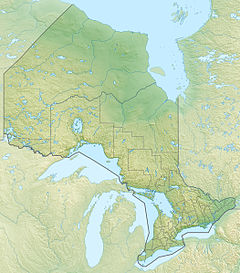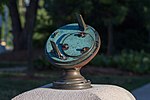History
When local lawyer, businessman, and member of federal parliament Hume Blake Cronyn died in 1933, his widow, Frances Amelia Cronyn (granddaughter of John Kinder Labatt) approached the University of Western Ontario with the idea of a memorial for her late husband. Mathematics and Astronomy professor Harold Kingston suggested that the university was interested in building an astronomical observatory. The result was the construction a new $40,000 (equivalent to $885,070in 2023) observatory on the university campus, funded by Mrs. Cronyn, and named in honour of her late husband. The grand opening was held on October 25, 1940. [1] [2]
Research
While the observatory's prime vision was as an educational and outreach facility, some very important research publications came out of work done with the telescopes and other equipment at the observatory.
Variable stars
The important research work of William H. Wehlau, staff, and students could not be summarized better than the obituary written by Bill's last graduating PhD student, Professor Jaymie Matthews, when he wrote, after Bill's sudden death in 1995, "Bill laid the foundation for many of the astronomical period-searching techniques we take for granted today. His 1964 paper with Kam-Ching Leung (ApJ 139, 843) [7] on the multiple periods of Delta Delphini was the first published use of Fourier integral techniques to interpret stellar light curves. The quality and quantity of data (25 nights of three-colour photometry) and sophistication of the fit (a sum of 6 cosines) would not be out of place in the modern literature on asteroseismology of Delta Scuti variables (see his paper in these Proceedings). In the next decade, Bill again was a pioneer; this time in stellar surface imaging through inversion of spectral line-profile variations into abundance and temperature maps of Ap stars. Such techniques are now widely used to analyse high-degree NRP in rapid rotators. By the 1980s, Bill's diverse interests in pulsation and spectral peculiarity converged in the rapidly oscillating Ap stars. He played key roles in the first detection of velocity oscillations in an roAp (rotating Ap) star and in translating optical-IR photometry of roAp pulsations into the first empirical atmospheric temperature profile for a star other than the Sun." [8]
Iris photometry
A locally modified Becker iris photometer was housed in the kitchenette in the basement of the observatory. [9] In 1964 Amelia F. Wehlau discovered a 1938 nova while using this photometer to study photographic plates of Messier 14 that had been taken by Helen Sawyer Hogg. [10] The plates were taken with the 74" telescope at the David Dunlap Observatory and 72" telescope at the Dominion Astrophysical Observatory between the years 1932 and 1963. The nova was only found on the 1938 plates taken at the David Dunlap Observatory.
Photometry
A photometer was deployed on the 254 mm (10") refractor roughly between the years 1957 and 1960. The first research from this instrument was the study of the brightness of Comet Arend-Roland by William and Amelia Wehlau, using data from 1957 and 1958. [11] This combination of instruments was also used in the published search for variability in the stars Gamma Equulei and HD 149728, using 1958 and 1959 data from the refracting telescope. [12]
In 1960 a 300 mm (12") Cassegrain reflector (purchased in 1958) came online with a locally built photometer, and this combination of equipment supplanted the photometer on the refractor. The first published use was in the successful search for light variablility in the star HD 173650, published in 1962 and using data from the summer of 1960. In later work using data from this instrument, William Wehlau pioneered Fourier techniques of detecting multiple periodicities in stars. The ground breaking work was the paper "The Multiple Periodicity of Delta Delphinii", Ap.J., Vol.139,April 1964, co-authored with graduate student Kam-Ching Leung. [7]
Post 1969
With the opening of the Elginfield Observatory in 1969 the use of Cronyn Observatory for research observing diminished. The last photometric observations published using Cronyn Observatory data was in 1995 in a paper by J. Bax, W.H. Wehlau and S. Sharpe. [13] However, very active machine and electronics shops based in Cronyn Observatory supported the research work of Elginfield Observatory until the 1.2m telescope at Elginfield was mothballed in 2010.
This page is based on this
Wikipedia article Text is available under the
CC BY-SA 4.0 license; additional terms may apply.
Images, videos and audio are available under their respective licenses.



